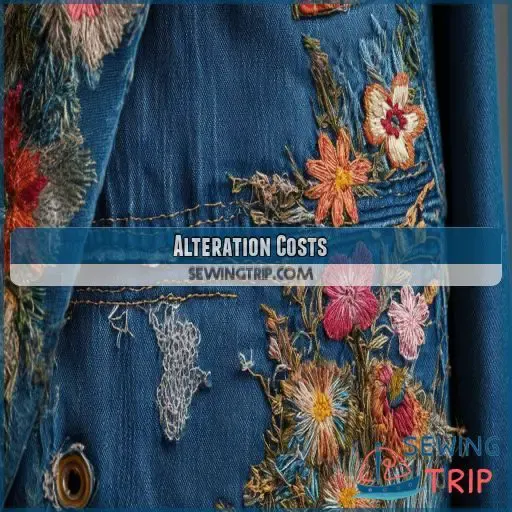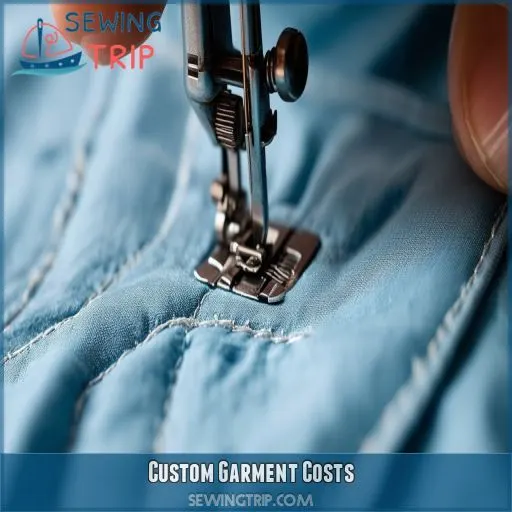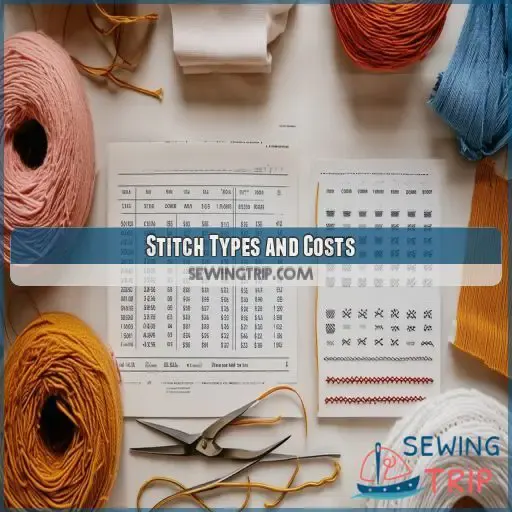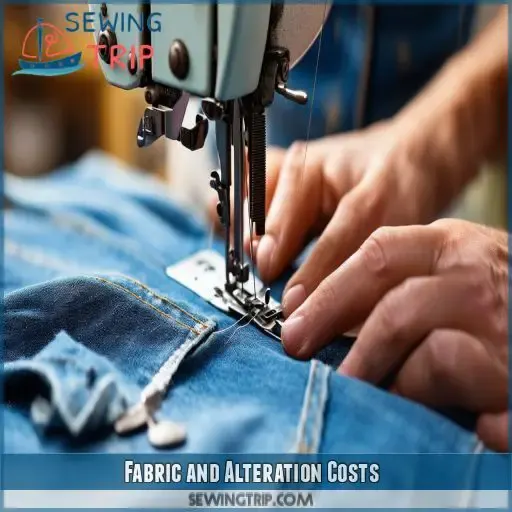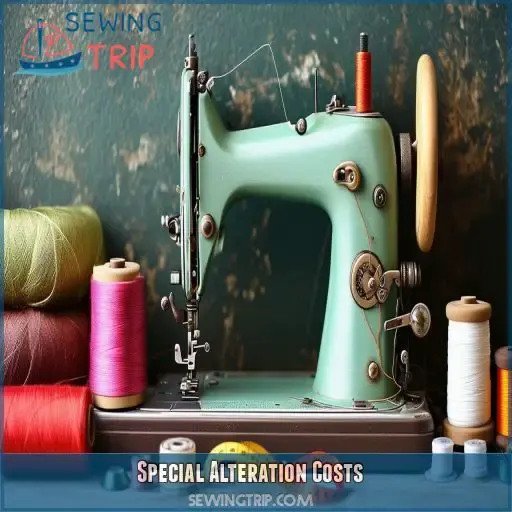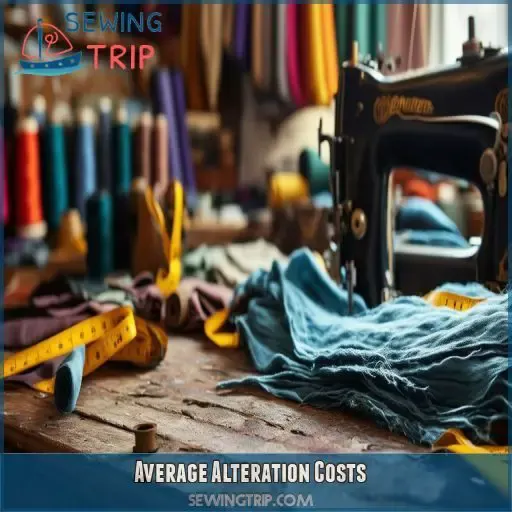This site is supported by our readers. We may earn a commission, at no cost to you, if you purchase through links.
 Figuring out how much to charge for clothing alterations and repairs in 2024 may be tricky. Herein is a pricing guide representing average costs of common alterations, such as shortening pants, setting jackets right, and hemming dresses.
Figuring out how much to charge for clothing alterations and repairs in 2024 may be tricky. Herein is a pricing guide representing average costs of common alterations, such as shortening pants, setting jackets right, and hemming dresses.
From custom-garment expenses to unique fabrics and stitch types, you will find right here most of what you need to know. Our guide gives all the precise and accurate details on how to repair denim jeans or bring vintage finds back to life while staying mastered in budgeting for alterations.
Table Of Contents
Key Takeaways
- Hemming pants won’t break the bank at $10-$20, but don’t be caught with your pants down when it comes to leather – it’ll cost you 50% more due to its temperamental nature.
- From blind-stitched bargains to top-stitched splurges, your wallet’s fate hangs by a thread. Hand-sewing delicate fabrics? That’s when things really start to get pricey, so maybe save the silk alterations for your wedding day.
- vintage clothing alterations are like fine wine – they come with age, complexity, and a heftier price tag. But hey, bringing grandma’s dress back to life? Priceless.
- The average alteration costs might make you sweat, but remember: a stitch in time saves nine. Invest in those tailored touches now, and you’ll be strutting your stuff in perfectly fitted threads for years to come.
Alteration Costs
When considering alteration costs, you’ll encounter a variety of options such as shortening pants or sleeves, enlarging garments by letting out fabric, and making body adjustments for jackets and shirts. Hemming skirts and dresses, restitching seams, and replacing buttons are also common services you’ll likely need.
Shortening: Pants, Sleeves
Hemming pants or shortening sleeves? You need to know the options—and the costs.
Compare Prices: – Pant alteration: $10-$20
- Sleeves adjustment: Sleeves no cuff detail $12-$20 cuffs detail cost $20-$30
- Sleeves up/shorten: $25-$50 jacket sleeves
Professional Tips in Tailoring: Use quality materials to ensure enduring results.
Precise fit all the way through do make a world of difference!
Enlarging: Letting Out
Enlarge garments and consider the peace of mind: added freedom and comfort. Tailor-made options to let out seams in pants, jackets, or dresses cater to this. The tailoring of vintage wear or specialized fabrics is an exact science, so seek a professional.
Precise measurements are the key to success. Prices vary, although, on petite or dress alterations, $25-$50 seems to be the range for waist adjustments and $20-$40 for hems.
Body Adjustments: Jackets, Shirts
Body adjustments may be necessary to make all the difference in jacket slim or shirt adjust tasks. Tailor services for shoulder adjust and sleeve slim ensure a perfect fit. Waist adjustments bring refinement to your silhouette.
Jacket alterations are also experience-centric, more so when it comes to expensive garment alterations or petite alterations. Get credible recommendations for tailors for the best results.
Hemming: Skirts, Dresses
You have many options for hemming skirts and dresses, from pleated skirt alterations to dress hem styles, applying the proper technique that will give you a custom fit. The prices for casual dress alteration or asymmetrical hems are between $15-$55. This doesn’t include length adjustments, complexity, and type of fabric.
Restitching, Button Replacement
Restitching assures a long life for the garment while replacing buttons gives it a refreshing look. It will cost from $5 to $20, depending on restitching methods and configurations of buttonholes.
In addition, there are thread color options to blend unnoticeably or contrast. Fabric matching is essential to ensure an invisible fix. Turnaround time is usually short, so you’ll start saving your money on clothes in no time and refresh old garments in the blink of an eye.
Custom Garment Costs
Consider the cost of custom garments; it’s costly if you consider the price regarding unique fabrics, sewing methods, and size of garments. All these things have to be taken into consideration as they bear a significant impact on the price to be paid.
Costly, Depending on Factors Such As:
Custom garments can be costly, depending on factors like special fabrics, unique sewing methods, and garment size. Formal dress alterations, for instance, often involve complex fabrics and specialty tailoring, which drive up prices. Unusual alterations or replace zipper jobs also add to the expense. The bigger and more intricate the garment, the higher the cost.
Special Fabrics
Special fabrics, say silk, velvet, or sequins, can add up vastly to the cost of alteration. These are delicate and require special handling; thus, their tailoring requires special expertise. Consider these factors:
- Special Fabric Options: Choose fabrics that make alterations easier.
- Fabric Complexity Considerations: Increasing complexity requires higher grade labor.
- Care After Alterations: Handle with care to preserve quality.
- Alteration Suitability in Fabrics: Some fabrics are more suitable to alterations.
Sewing Methods
Methods of sewing for custom garments are reflected in the costs. Complex patterns or intricate designs require more time and raise, quite naturally, prices.
High-quality threads and the selection of fabric will add to the cost, too.
Custom fitting and attention to design details to ensure a perfect finish—these meticulous methods come quite naturally premium-priced. Precision in every stitch defines value and craftsmanship.
Garment Size
The size of the garment has much to do with costs. Whether resizing due to body type or special features, more oversized garments require more fabric and time.
Various garment types and textiles, like denim or silk, require special care. Tailoring is essential for special occasions so that customers get tailored garments just as per their particular needs while at the same time not compromising on work quality.
Stitch Types and Costs
Knowing the proper stitches and their associated costs will allow you to be an informed decision-maker regarding your alterations. Blind-stitched hems are the least expensive, and top-stitched hems, as well as hand sewing for sensitive fabrics, will be more so.
Blind-stitched Hem: Less Expensive
A blind hem is a stitch that’s nearly invisible on the fabric’s front, making it ideal for a clean, professional look. It’s less expensive compared to other hemming methods. This technique is often used for hemming pants, skirts, and dresses, ensuring your clothing looks polished without breaking the bank. Perfect for subtle, budget-friendly adjustments.
Top-stitched Hem: More Expensive
A top-stitched hem, often favored in fashion statements and garment repairs, can be pricier. This method involves visible stitching, which enhances durability and design. Ideal for those seeking stylish consultations, hem alterations using top-stitching reflect designer tailoring. The precision and craftsmanship required justify the higher cost, ensuring your clothes aren’t just repaired but exquisitely refined.
Hand Sewing: Higher Cost for Delicate Fabrics
Hand-stitched garments demand a higher cost, especially for delicate material alterations. Custom fabric needs and vintage cloth repairs require specialty sewing techniques due to the intricate nature of the fabrics. Delicate materials such as silk or lace often need careful handling, pushing the price up. Expect higher rates for these services, reflecting the necessary skill and precision involved.
Fabric and Alteration Costs
When altering clothes, keep in mind that denim generally costs $4-$5 more due to its durability. Leather alterations are even pricier, often 50% higher, because of the specialized skills required.
Denim: $4-$5 More to Alter
When altering denim, like Levi’s or Wranglers, expect to pay an extra $4-$5 due to its thicker, tougher fabric. Jeans alterations often require specialized needles and techniques, ensuring durability without sacrificing style. Whether it’s hemming, slimming, or waist adjustments, denim tailoring demands precise craftsmanship to maintain the garment’s integrity. Be prepared for slight additional costs.
Leather: 50% More Expensive Due to Specialty Tailoring
Leather alterations cost 50% more due to specialty tailoring. Here’s why:
- Complex Design: Leather demands precision in cutting and sewing.
- Fabric Costs: Higher for this durable material.
- Specialty Tailoring: Skilled hands required.
- Delicate Fabrics: Despite its durability, leather can tear or warp if not handled correctly.
Special Alteration Costs
Special alteration costs can vary widely, whether you need proportional adjustments for petite tailoring, complex fabrics for costume alterations, or repair and restoration for vintage pieces. These services often require specialized skills and threads, influencing the final price.
Petite Tailoring: Proportional Adjustments
Tailoring petite ensures that the fit is excellent with proportional adjustments to the child’s clothing, outgrown quickly due to growth spurts. This tailoring style also benefits special-occasion outfits and school uniforms, ensuring both comfort and style. By altering these garments, you ensure a neat and tailored appearance, keeping clothes fitting well and extending their life.
Costume Alterations: Complex Fabrics, Specialized Threads
Costume alterations, especially for complicated fabrics, can be intricate. Be prepared to make adjustments for specialized thread types, fragile fabrics, and allowances for embellishments—ensuring everything is historically accurate.
- Intricate embroidery
Fragile materials
- Authentic replica creation
- Matching original stitch patterns
- Handling delicate embellishments
These elements can increase costs significantly, as attention to detail is paramount.
Vintage Restoration: Repair and Restoration Services
When dealing with vintage restoration, the focus is often on historical accuracy and sentimental value. Restoration techniques used for vintage fabrics require precision and expertise, contributing to higher repair costs. Ensuring these pieces are delicately handled, re-stitched, and brought back to life without compromising their original charm is key to preserving their heritage and personal significance.
Average Alteration Costs
You’ll incur varying costs for altering different types of clothing, reflecting factors like fabric, complexity, and adjustment type. For example, altering tops and blouses can range from $12 – $35, while adjustments on jackets and coats can span $25 – $90, ensuring detailed customization for your specific needs.
Tops, Shirts & Blouses: $12 – $35
For tops, shirts, and blouses, the average alteration cost is between $12 and $35. Hemming down in length for a sweater or correcting the sleeve length is around $12-$20. Changes to the shoulders will be around $20-$30; heavily embellished items can cost $35 or more.
Pants & Bottoms: $10 – $45
Moving from tops and shirts into pants and bottoms, it’s possible to shorten a pair of pants for $10-$20.
Waistband adjustment is anywhere between $25 to $45.
Leg slimming is another widespread alteration, which would be from $20 to $40.
Hemming pants—for those with pleats or other details—might run $35 to $45.
Detailed tailoring brings about the perfect fit of your pants for ultimate comfort and overall style.
Denim: $10 – $40
For denim, their alteration pricing will run from $10 to $40. Their services include, but aren’t limited to:
- Slim leg: Achieve a sleek and modern look.
- Adjust waist: Get a perfect fit at the hips.
- Pleated hem: Style doesn’t have to sacrifice comfort.
- Shorten sleeves or original hem: Retain an original look for the garment.
Each service ensures a perfect fit in your denim.
Jackets & Coats: $25 – $90
Jacket and coat alterations begin at $25 and go up to the pay of $90. Among them, jacket shortening, slimming, or altering the sleeve are some of the services. The overall is as follows:
| Type of Alteration | Cost Range |
|---|---|
| Shorten | $30 – $90 |
| Slim | $40-$60 |
| Shorten Sleeves (cuff) | $25-$40 |
| Shorten Sleeves (shoulder) | $30 – $50 |
| Slim Sleeves | $25-$45 |
These alterations ensure a perfect fit for everyone, from wedding gowns to highly bedecked ones, attaining finesse and control over your wardrobe.
Other: $15 – $150+
Other alteration services range from $15 to $150+. Here’s what you can expect:
- Zipper repair: $15 – $25
- Embellishment removal: $15 – $50
- Button replacement: $10 – $20
- Small jobs: Starting at $10
- Complex repair services: $100 and up
These alterations rejuvenate garments, ensuring they remain stylish and functional.
Frequently Asked Questions (FAQs)
How much should hemming pants cost?
Think of hemming pants as an investment in perfection—it usually runs between $10 and $ This precise adjustment ensures perfection of the fit, thus giving you the freedom to master your style with ease.
Why is alteration so expensive?
The prices of alterations may seem high, but when one considers that the work is labor-intensive, requires specialized skills, and is precision-driven, this may appear justified. Complex fabrics, detailed adjustments, and delicate hand-sewing increase this time and expertise manifold, hence the higher prices.
How much should hemming a dress cost?
Think of waving goodbye to long hemlines. Hemming a dress typically costs $15 to $ The price depends on fabric and design complexity, offering a tailor-made solution that’s much cheaper than buying new.
How much do alterations cost for a top?
Altering a top can cost between $12 and $ Simple sleeve shortening typically costs $12-$20, while more intricate modifications like slimming the top can range from $25-$ Costs vary based on specific adjustments required.
How much does alterations cost?
Alterations cost between $10 and $150, depending on the garment and complexity. Hemming pants ranges from $10-$20, while adjusting jacket shoulders can start at $ Leather items and vintage restoration are pricier due to specialized work.
How much does it cost to alter clothes?
Altering clothes varies: heming costs $10-$55, waist adjustments $15-$45, sleeves $12-$ Complex garments like jackets may run up to $ Leather and wedding gowns will cost more due to fabric delicacy and tailoring expertise.
Why do clothes alterations cost more?
Clothes alterations cost more due to the skill and time required, as well as the complexity of fabrics and designs. Specialized techniques and materials, such as leather or intricate stitching, further increase the pricing.
How much does a Tasker alterations cost?
A Tasker’s alterations typically range from $10 to $90, varying by garment type and complexity. For precise details, explore specific services like hemming or adjusting waistbands, ensuring the perfect fit without breaking the bank.
Do I need an appointment for alterations?
Yes, you usually need to make an appointment for alterations so the tailor can plan his time for your particular needs. It’s always best to call ahead and confirm with your tailor.
How long do alterations typically take?
Rome wasn’t built in a day, and neither are alterations. Typically, they take about 1-2 weeks. For complex items, expect up to 3 weeks. Always consult with your tailor for precise timelines.
Can you alter vintage clothing?
Absolutely, you can alter vintage clothing. However, because it often involves delicate fabrics and intricate designs, expect higher costs. Skilled tailors with experience in vintage restoration can help maintain the garment’s integrity.
Do you have experience with delicate fabrics?
Yes, I’ve got experience with delicate fabrics. I handle silk, chiffon, and lace with care, ensuring precise stitching and gentle treatment. Trust me to maintain the integrity and beauty of your garments.
What is your redo or adjustment policy?
Should adjustments not meet your expectations, we’ll repeat them at no extra cost within 14 days. If, by any chance, you aren’t satisfied, we’ll redo adjustments to ensure that the final alteration leaves you consistently with the perfect fit. Our priority is this: your contentment.
Conclusion
Imagine knowing just how much to charge with confidence for clothes alterations and repairs. Now, from the simplest hemming to the most complicated vintage restorations, you’ll learn how to price any alteration need that crosses your path.
This has to be considered: prices fluctuate based on many factors, such as type of fabric, stitch complexity, or garment size. Therefore, this guide will go a long way in helping one understand how to price shortening pants or bring a resilient jacket back to life.
Want to stay informed so that you’ll never pay too much for clothing alterations and repairs again?

